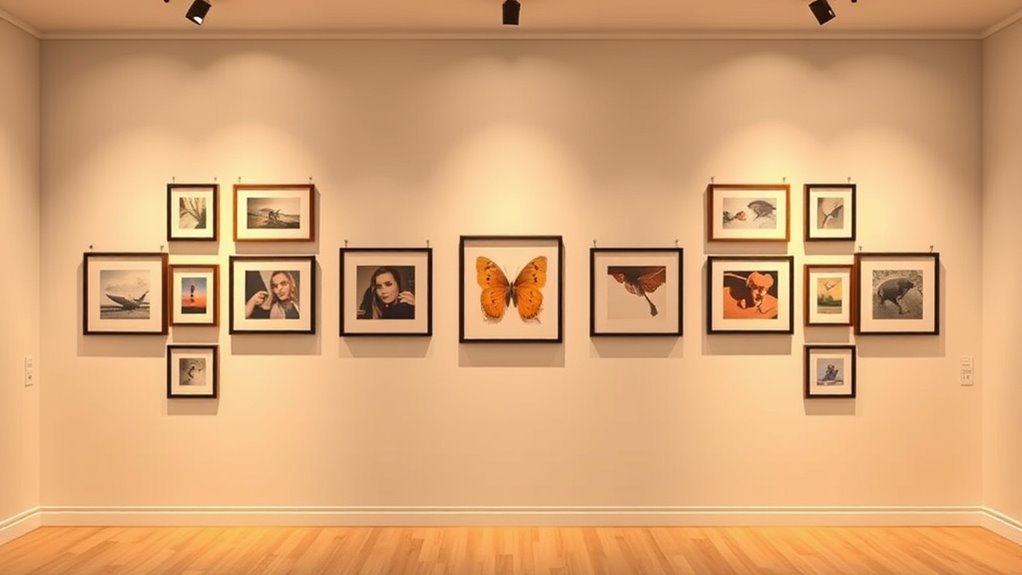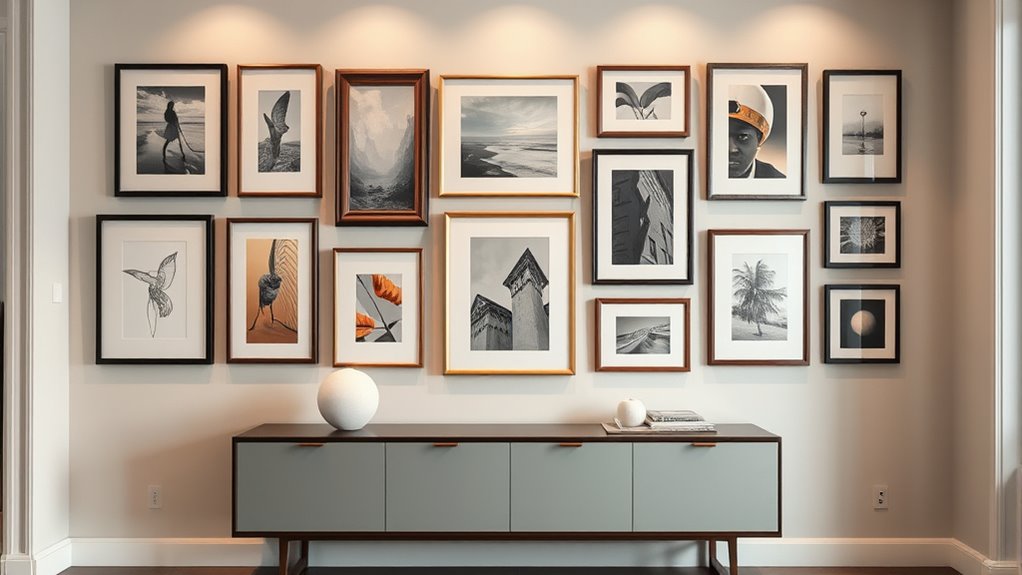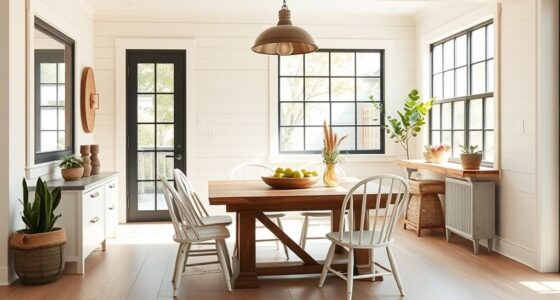Designers use several key art placement rules to create visually appealing and balanced displays. Start by choosing a focal point and keep artwork centered at eye level, around 57-60 inches from the floor. Maintain 2 to 6 inches of spacing between pieces for cohesion and consider the size and shape of each piece. Use proper lighting to highlight details and experiment with layouts using painter’s tape before hanging. If you keep exploring, you’ll discover even more tips for stunning art arrangements.
Key Takeaways
- Hang artwork at eye level, approximately 57-60 inches from the floor for optimal viewing.
- Maintain 2 to 6 inches of spacing between pieces to create balanced and cohesive displays.
- Use larger pieces as anchors and arrange smaller works around them for visual interest.
- Consider the relationship to furniture and architectural features to ensure harmonious placement.
- Utilize lighting strategically to highlight focal points and add depth to the art arrangement.

Have you ever wondered how to position artwork so it enhances your space? The key lies in understanding some fundamental art placement rules that designers swear by. When it comes to wall art, proper placement can transform a room from ordinary to extraordinary. One of the most popular techniques is creating a gallery arrangement, where multiple pieces are grouped to form a cohesive display. This approach not only adds visual interest but also helps balance the room’s aesthetic. To start, think about the size and shape of your wall and the artwork you want to hang. Larger pieces tend to anchor a space, while smaller ones can be grouped for a more dynamic effect. When arranging your gallery, keep in mind that the center of your artwork should generally be at eye level, about 57 to 60 inches from the floor. This rule ensures that your wall art feels natural and accessible, no matter where you’re standing.
Next, consider the spacing between each piece in your gallery arrangement. The ideal gap is typically between 2 to 6 inches, depending on the size of the artwork and the wall. Too tight, and the display may feel cluttered; too wide, and it can seem disjointed. A balanced spacing helps unify your collection and creates a harmonious flow. When positioning individual pieces, think about their relationship to furniture and architectural features. For example, hang artwork above a sofa or console table so there’s a visual connection, but avoid placing it so high that it feels disconnected. For larger walls, a symmetrical layout often works best, with pieces aligned along a central line or grid. In contrast, asymmetrical arrangements can add a modern, eclectic vibe, as long as you maintain a sense of intentional balance. Additionally, understanding art placement rules can help you create a more cohesive and appealing display.
Lighting also plays a vital role in showcasing your wall art. Proper illumination highlights details and adds depth, so consider installing picture lights or accent lighting to enhance your gallery arrangement. Remember, the goal is to create a focal point that draws the eye, but without overwhelming the space. Finally, don’t be afraid to experiment. Use painter’s tape to visualize your gallery arrangement before making any holes, and adjust as needed. Artistic placement isn’t about strict rules but about creating a composition that feels right for your unique space. With these guidelines, you’ll be on your way to curating a stunning display of wall art that elevates your entire room.
Frequently Asked Questions
How Do Lighting Conditions Affect Art Placement Decisions?
Lighting conditions considerably influence your art placement decisions. You should consider lighting effects, such as glare or shadows, that can diminish visibility or alter the artwork’s appearance. Natural illumination, like sunlight, enhances colors but can cause fading over time, so place art away from direct sunlight. Using controlled lighting helps highlight details and creates the desired mood, ensuring your art looks its best in various lighting environments.
What Role Does Room Size Play in Artwork Selection?
Room size greatly influences your artwork selection by considering wall proportions and visual balance. In larger rooms, opt for bigger pieces that fill the space without overwhelming it, maintaining harmony. Conversely, smaller rooms benefit from smaller or mid-sized artworks to avoid clutter. Always assess the wall proportions to make sure your chosen art complements the room’s scale, creating a balanced and inviting atmosphere that feels proportionate and visually appealing.
How Can Art Placement Enhance Room Functionality?
You can enhance room functionality by strategically using art to create art balance and focal point placement. Position pieces where they draw attention without overwhelming the space, guiding the flow and emphasizing key areas. For example, placing a bold artwork above a sofa establishes a focal point, making the room feel inviting and organized. Thoughtful art placement improves navigation and highlights the room’s purpose, making it both functional and visually appealing.
Are There Cultural Considerations in Art Arrangement?
You should consider cultural symbolism and tradition preservation when arranging art, as your choices can speak volumes about your respect for diverse backgrounds. Think of your space as a tapestry, where each piece weaves in cultural meaning. By honoring specific traditions and symbols, you create a respectful environment that celebrates diversity, fostering understanding and connection. This thoughtful approach not only enriches your space but also respects and preserves cultural identities.
How Often Should Art Be Repositioned or Rotated?
You should consider art repositioning or art rotation every few months to keep your space fresh and engaging. Regular art rotation allows you to showcase different pieces and maintain visual interest. If you notice your current arrangement feels stale or doesn’t suit your mood or decor, it’s a good time to reposition or rotate your artwork. This practice helps refresh your environment and keeps your art collection dynamic and exciting.
Conclusion
By mastering art placement rules, you can transform any space into a stunning masterpiece. When you follow these guidelines, your walls will become the envy of the universe, commanding attention and admiration. Remember, even the tiniest misstep can throw off the entire vibe—so pay attention to spacing, height, and balance. With a little practice, you’ll elevate your decor game to legendary status, proving that perfect art placement is truly an art form in itself.








